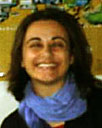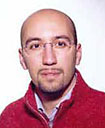|
People
|
Work Description
|
|
Rita DE MASI
|
I'm working as PhD on the construction of a silicon microstrip detector for the COMPASS detector. COMPASS (NA58) is a fixed target experiment on the SPS at CERN, aimed to the investigation of hadron structure and hadron spectroscopy. Due to their high spatial resolution (few um) the silicon detectors are used for beam detection upstream of the target. Because of the high beam intensity, after an estimated time of one year of data taking, the radiation damage will produce a reduction of the Charge Collection Efficiency (CCE) in the silicons to make them any longer usable. The operation at a temperature of ~130 K (Lazarus effect) reduces the influence of radiation damage, allowing to operate them for the whole duration of the experiment. I'm presently working on the development and test of silicon detectors operated at low temperature to be installed this year in COMPASS. |
|
Biagio DI MICCO
|
For my degree study, I worked in Chorus, to study the re-calibration of the hadronic spettrometer. Now I'm attending the PhD courses at Roma Tre University and I'm working in the KLOE experiment. It is a universal detector operating on the DAFNE e+e- collider at Frascati near Rome. DAFNE works at the resonance of the Phi meson (about 1020 MeV) (It's a Phi factory). KLOE can study the radiative decay of the Phi too, and the decays of its decaying particles. At the moment I'm working on the C violating decay of eta into three photons, it's predicted from the SM at 10^-12, so an observation of this decay with an higher branching ratio would be a claim for new physic. For my phd degree I will work on the decay eta -> p0 gamma gamma, it has been observed by only one experiment with a branching ratio far from the most theoretical models predictions. |
|
Mauro DINARDO
|
For my Ph.D. thesis I am working on BTev, a ìb physics esperiment which will be built at Fermilab. THe BTeV experiment is conceived for the sistematic study of heavy hadrons decays with b (and c) quarks, in order to determine with high accuracy the Standard Model parameters and, eventually, detect possible new physics effects. The main measurements that would be performed are mixing, CP violation and rare decays of hadrons with b and c quarks. The group which I work in is responsible for the Silicon micro-strip forward detertor tracking; I am personnally involved both in experimentals test on the detector (e.g. radiation damage) and in the Monte Carlo simulation for B decays. |
|
Eric DUMONTEIL
|
ALICE at CERN LHC will be the experiment dedicated to the study of the Quark Gluon Plasma, a new state of mateer which was discovered in 2000 at CERN. My PhD thesis consists in studying the possibility to measure the suppression of the different resonances of the upsilon family in such a state. The experimental part of this work consists in getting a good knowledge of the tracking chambers of the dimuon arm, used for the upsilon invariant mass reconstruction, while the physics simulation will involve different topics like event generation or background studies. |



